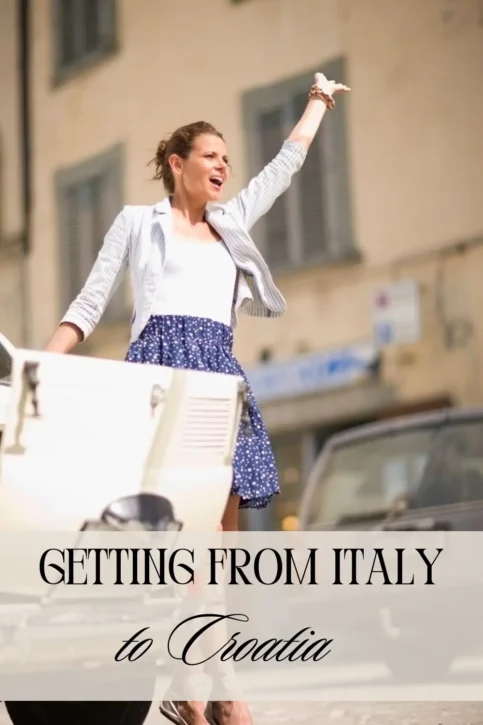Traveling from Italy to Croatia is easier than most people think – and a great choice for those flying from countries that don’t have direct flights to Croatia (like the US, Canada or Australia).
The two countries are neighbors across the Adriatic Sea, connected by short budget flights, ferries, scenic coastal roads, and even night buses that run daily – sometimes even multiple times per day.
I am traveling at least a dozen times a year between these two countries and who better than me can give you useful tips how to reach Croatia from Italy or vice-versa?
Below, you’ll find a full breakdown of how to get from Italy to Croatia by plane, ferry, bus, train, or car, plus my advice and tips to make each choice perfect.
Quick Overview: Best Ways to Travel from Italy to Croatia
If you’re in a hurry and just want to know which option to pick, here’s a quick summary:
- Fastest: Direct flight (Rome or Milan to Split or Dubrovnik).
- Most scenic: High-speed ferry from Venice to the Istria Peninsula (Rovinj, Poreč, or Pula).
- Best value: Bus from Trieste to coastal Croatia.
- Most flexible: Driving across the border (ideal if you’re renting a car).
Typical travel times and price ranges, but we’ll get in-depth with them all below.
Good to know: Since Croatia joined the Schengen Area in 2023, there are no passport checks when traveling between Italy and Croatia, although random checks might still happen from time to time, so make sure to always have your travel documents on you!
Getting from Italy to Croatia by Plane
Flying is by far the fastest and most convenient way to get from Italy to Croatia. In the last few years, several low-cost airlines have opened direct routes connecting major Italian and Croatian cities, and the number of options simply explodes during summer.
The most popular flight options are:
- Rome – Split (Croatia Airlines): year-round, direct, about one hour. Tickets are usually more expensive than low-cost options, but reliable and frequent.
- Rome or Milan – Split and Dubrovnik (EasyJet): seasonal, typically May to October, with fares starting around €40 if booked early.
- Rome – Dubrovnik, Split, Zadar, and Pula; Palermo and Catania – Split (Vueling): seasonal routes between late May and late August, often under €50.
Other airlines such as Ryanair, Wizz Air, and Volotea have also started offering budget-friendly connections to Croatia’s coastal airports, especially from northern Italy.
Most direct flights take one to one and a half hours, depending on the route and land at one of the main airports in the country. For a full guide, read my article listing all International Airports in Croatia.
Getting from Italy to Croatia by Ferry
If you’d rather enjoy the Adriatic Sea than fly over it, ferries are an excellent alternative, especially if you’re traveling from the Italian coast or driving a car.
Ferries are comfortable, scenic, and often run overnight, which can save both time and the cost of one night’s accommodation. They’re also the most practical option if you’re starting from Ancona, Bari, or Venice. Here are the details:
1. Ancona – Split or Zadar ferry
This is the most popular route, connecting central Italy with central Croatia. It’s operated by Jadrolinija, Croatia’s national ferry company and it runs all year long.
You can check out the company’s website here for up to date schedules (available in English)
Alternately, head over to DirectFerries and browse their huge list of offers with ferries from Italy to Croatia, departing from and arriving to various cities.
The crossing time is around 10-11 hours (overnight). You can travel as a foot passenger or bring your car. Cabins and reclining seats are available for added comfort.
2. Bari to Dubrovnik ferry
Also operated by Jadrolinija, typically between April and October. Duration: about 10 hours. This is perfect for travelers coming from southern Italy. This is also a solid option if you want to continue your trip toward Montenegro or southern Dalmatia after arriving in Dubrovnik.
3. Venice to Istria (Rovinj, Poreč, Pula, Umag)
If you’re visiting Venice, hopping across to Croatia’s Istrian peninsula (see the map here) is easy and quick. T
here are multiple options but the main one is operated by Venezia Lines, a high-speed passenger-only service, usually working between April to October. Travel time is between 3 to 4 hours, depending on your destination.
This is a great choice for a short side trip – even for a day or weekend – to charming towns like Rovinj or Pula.
Getting from Italy to Croatia by Bus
For most travelers, the bus offers the best balance between price, comfort, and convenience and it’s usually the method I choose unless I’m in a hurry.
There are plenty of buses between Italy and Croatia and they are modern and surprisingly fast.
Trieste is the main Italian hub for Croatian routes and it’s the one I use the most, as it gives you the chance to reach any city in the country by bus (like Umag, Poreč, Opatija, Rijeka, Zagreb, Zadar, Šibenik, Split, and Dubrovnik and more).
The most important Italian bus carriers from Trieste are SAF Udine and APT Gorizia. You can also consult all international bus departures from the Trieste bus terminal website.
Ticket prices usually range between €25-€60, depending on the distance, the company, but also how well in advance you book. For more about traveling in Croatia by bus, I recommend reading my in-depth guide here.
Of course, apart from Trieste, there are multiple other Italian cities that are connected with Croatia, so visit their official websites for route information.
Getting from Italy to Croatia by Train
Taking the train between Italy and Croatia is technically possible, but not recommended, even by me who is a massive train travel fan. But because trains in Croatia are slower, but especially because there are no direct high-speed lines between the two countries, it’s best to skip them.
If you’re passionate about train travel, you can still make the journey, but expect to make at least one or two changes along the way. The most common route goes from Trieste (Italy) to Ljubljana (Slovenia) and then on to Zagreb (Croatia).
This can take anywhere between 8 to 10 hours, depending on the connections – sometimes longer. Once in Zagreb, you can continue by bus or domestic train to other destinations.
But keep in mind that Croatia’s rail network has not been a priority for many years now, the government investing instead into the highways and coastal roads, so there are better options out there.
Driving from Italy to Croatia
If you prefer full freedom, driving is another excellent way to travel from Italy to Croatia, although I believe that most travelers will skip this as it’s the least convenient.
However, if you plan to drive (you will share the same excellent roads that buses travel on, so expect easy trips), you will also have to pass through Slovenia – and also Trieste will be the most likely entry point for you.
All highways in Croatia are in excellent condition, with modern toll systems (you can pay in euros or by card). Slovenia requires a vignette (toll sticker), which can be purchased online or at any service station near the border.
Keep in mind that finding parking spots in the coastal cities during the summer is a bit of a nightmare, too – so prepare for this mentally.
Renting a car and crossing borders
If you rent a car in Italy, make sure the rental company allows cross-border travel into Croatia – most do, but some may require a small insurance fee or prior notice.
It’s also possible to bring your car aboard ferries, which can save a long drive if you’re heading further south.

Final Thoughts
I’ve traveled between Italy and Croatia countless times and I can agree that each option has its own charm. Therefore, choose your means of transportation based on personal preferences and how quickly you want to get to your destination.
If you want speed, then flying is usually faster (although if you’re in Trieste and you need to get to Umag, a bus will be faster). Ferris offer a great experience and should be tried at least once, while buses are generally affordable and fast. So it’s good to know that you have options.
If you have any comments or questions about specific routes, ferry companies, or timing, drop a comment below.


Leaving from Bari to Dubrovnik but can’t find a flight out of Bari that is direct. Help!